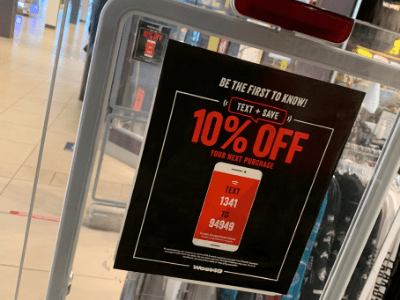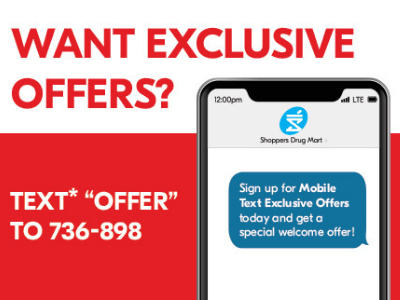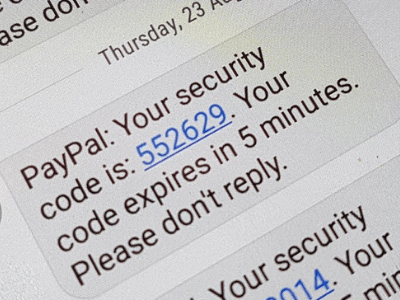Learn everything you need to know about sms short codes in Canada. We’ll go through the essentials, a few use cases, regulations, how to procure a short code and more.
Raange is a Canadian SMS marketing company, and a recognized messaging partner with the CWTA. We host many sms short codes in Canada for our partner companies. We know a thing or two about Canadian short codes.
What is an SMS Short Code?
A SMS short code is a 5 or 6 digit special number designed for high volume two-way text messaging. You can use short codes to send and receive MMS and SMS messages, execute large one-to-many messaging campaigns and for Text to Join.

In the image above, West49 is running a Text to Join promotion using a short code 94949. Get 10% off your next purchase by texting “1341” to 94949.
The name “short code” has to do with the length of the number compared to more common ten-digit long codes. We go into more detail about the difference between sms short codes and SMS long codes in this article.
What type of organizations use short codes?
Businesses or brands planning to send very high volumes of messages use short codes. The types of organizations that use short codes include Banks, Software companies, Large Retailers, Government, Large Fast Food Chains, Health Care Companies and more.
Larger organizations also like short codes because sms short codes are much easier to remember than long 10-digit numbers. You can provision vanity short codes that either spell out a word or have a significant meaning, like PIZZA (74992) or 420420 for the cannabis industry. Your sms marketing program will be more successful with an easy to remember number.
Learn how this 100-store retailer is using short codes in their sms marketing strategy.

Read more: Engaging in a Noisy World: The Case For Suzy Shier
Short Code Use Cases
There are many reasons to use a sms short code in Canada, but we’ll go over 3 important use cases that apply to all short code programs, not just Canadian short codes.
Text to Join
Shoppers Drug Mart and many other brands use Canadian short codes to help collect opt-in customer contacts. We call these programs Text to Join.

In the offer, Shopper provides a digital coupon for 10,000 PC Optimum bonus points for customers who join their text alerts program.
Two-factor Authentication (2FA)
Two-factor authentication or 2FA is another use for a sms short code in Canada. 2FA is a security procedure that requires two distinct forms of identification.

For example, when you sign into your bank account, you’ll receive a one-time password sent via SMS as your second id verification.
Time-Sensitive Marketing Promotions
Consumers love deals! There is no better way to get a time-sensitive promotion into the hands of your customer than using sms marketing.

SMS short codes are the best option to send high volumes of messages in a short period of time.
Companies will share one-time deals, digital coupons or info about sales to opt-in customers. Short codes have higher throughputs. Therefore, you can process more messages in a shorter period of time.
As we will discuss shortly, carriers vet and approve all short codes for use. Messages sent using short codes in Canada are subject to less filtering.
A few more examples we didn’t get into include sending reminder messages, tracking information for packages, e-receipts, account alerts, appointment reminders, payment reminders, chat, and many many more.
Short Code Restrictions in Canada
You cannot use short codes for international text messaging. You can only send messages in the country where the short code is registered. This is because short codes can only message users on the carriers within that specific country. In Canada, Rogers, Telus, Bell – all carriers – approve all short codes in Canada.
You can no longer use shared short codes. Meaning multiple brands cannot piggy-back off the same short code to send messages. This was a very popular technique to reduce the cost of the short code – as you can spread the cost across multiple companies.
The Canadian Common Short Code Application, set out by the Short Code Council, sets out restrictions around “adult oriented content.” This outlines limitations around age restricted content, such as services involving alcohol, tobacco, marijuana/cannabis, gaming, and any other adult oriented or mature content. Before you can start, the Short Code Council (SCC) pre-approves all short code programs in Canada.
While you’re planning your sms marketing strategy it is very important to be working with a service provider who can help you to manage the regulations around Common Short Codes or CSC’s in Canada.
Short Code Lookup Canada
Companies are always wondering what short codes are still available? The CWTA manages the Canadian short code directory. It lists all the current short codes and program details in Canada.
Pricing for Short Codes
The CWTA charges an initial setup fee and 3-month lease of $1,500 and a monthly fee of $350 for a short code. There is also a one-time carrier provisioning fee of $3,000 paid to tier 1 aggregators. Keep in mind, these are costs associated with procuring and leasing a short code.
Once you have the short code, each messaging service provider or sms marketing software will charge their pricing plus additional carrier fees. Always ask about carrier fees!
Applying for a SMS Short Code in Canada
Working with your messaging partner will be very important in putting together a successful short code application. The Short Code Council in Canada reviews and approves all short code applications.
Your application will include program information, what it’s going to be used for, customer experience – flows, keywords and opt-ins – pre-launch forms, messaging volumes etc. It is very important to work alongside all associated parties to put together a successful application.
We tell our customers it can take up to 3-4 months for the provisioning of a new short code. Keep in mind there are always delays. There are application deadlines for new short code applications in Canada. It’s called the SMS Short Code Carrier Brownout Notice. The short code Brownout period is generally from mid-November to mid-January. This is the brownout period when SCC’s will not be provisioned. Not all applications are accepted on the first try. Make sure you’re signing up for your short code application early.
Reach out to our Team to help you get started.
Short Code Regulations in Canada
In Canada, you need to be aware of the telemarketing rules for compliance. The Canada’s Anti-Spam Legislation or CASL as set out by the Canadian Radio-Television and Telecommunications Commission (CRTC). This sets out how and when you can start sending text messages to consumers in Canada. More on this in a different article to come.
There are multiple organizations that manage short code programs in Canada. The CWTA represents companies services and products across the wireless sector in Canada. It represents the industry before all levels of government and various regulatory agencies. The CWTA is the Short Code Administrator in Canada. You can find the application here.
Once again, this entire process is best handled with your messaging partner.
How to get started with Raange?
Need to work with a company to navigate compliance and registering for a new short code program.
SMS short code marketing in Canada is simple and easy with Raange. To get started with Raange, you can also request a demo. Alternatively, you can call us at (844) 472-2643.





